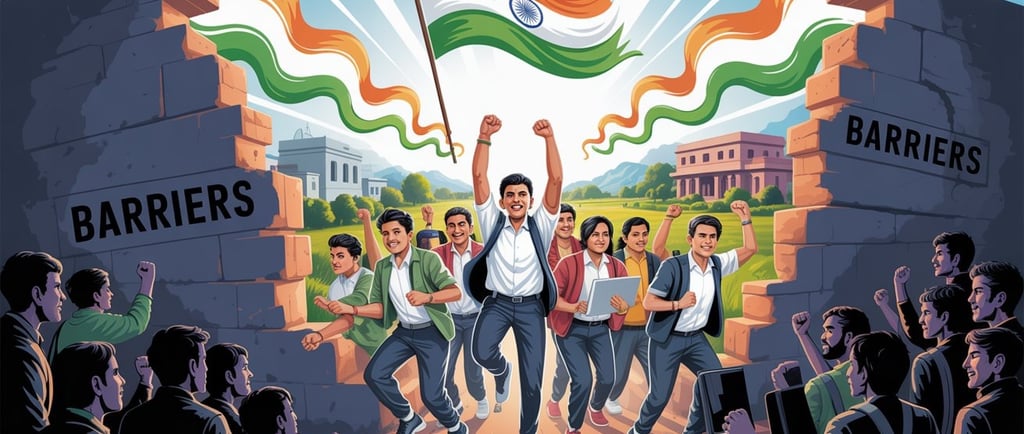YUVA AUR PRAKRTI KE SATH
From Schools to Panchayats: Making Democracy Real for Youth
A call to reimagine Indian democracy by giving youth real seats at local decision-making tables instead of waiting until they turn 18 to participate.
YOUTHGOVERNANCELOCAL GOVERNMENT
Aditya Janu
10/2/2023


In textbooks, India’s democracy is described as a system “by the people, for the people.” Yet for millions of young Indians, this promise feels distant. We’re told to vote at 18, to “be the change,” to speak up — but the institutions around us, from school boards to village panchayats, often fail to offer real entry points for meaningful participation.
At the grassroots, India’s democratic strength is often strongest on paper but weakest in practice. Local bodies — municipal councils in cities and gram panchayats in villages — are meant to be frontline actors on issues like disaster response, water scarcity, and public health. But in reality, many remain underfunded, poorly trained, and overshadowed by higher bureaucracies. Research by the Centre for Policy Research and others shows that most states devolve barely 20–25% of the subjects listed under the Eleventh and Twelfth Schedules of the Constitution. Instead of real autonomy, decisions still flow from district headquarters or state capitals, sidelining local voices and disempowering communities.
Democracy Must Begin Before Age
For most students, “democracy” begins and ends with ceremonial school captain elections — processes that rarely give real responsibility or budgetary power. But what if civic education moved beyond textbooks and exams into practice?
What if every school ran youth councils modeled on panchayats, complete with oversight of real budgets for projects like waste segregation or water conservation?
What if teenagers debated policy drafts impacting their neighborhoods, instead of only simulating UN debates?
What if students attended ward meetings or joined climate task forces to witness how local governance actually works?
With nearly 65% of India’s population under 35, democracy cannot be taught purely in theory; it must be experienced early.
Global and Indian Lessons
Globally, countries have institutionalised youth engagement in local governance, moving it beyond token gestures:
In Porto Alegre, Brazil, participatory budgeting includes youth voices in deciding how significant parts of the municipal budget are spent.
Japan’s Kodomo Councils let students formally advise on city planning.
South African municipalities run youth units directly within local government structures.
India too has notable but scattered examples:
Kerala’s People’s Plan Campaign encouraged local planning by communities, including young people.
Sikkim’s eco-clubs in schools advise local panchayats on environmental decisions.
Delhi’s “Bhagidari” program briefly opened space for students and residents to interact directly with city officials.
These examples show what’s possible — but remain exceptions rather than the rule. Imagine if every district established a standing Youth Policy Forum feeding directly into planning discussions. Or if every panchayat notified and funded a Youth Advisory Council to consult on local priorities.
Elections Are Not Enough
Casting a vote every five years isn’t the only act of citizenship. Democracy should live in classrooms, town halls, gram sabhas, community councils, and local protests — the spaces where policies are debated and shaped. Today, young people are largely excluded from these forums; ideas are dismissed as naive, or engagement is limited to social media activism.
Yet democracy thrives not by permission, but by structure — and by creating genuine pathways for youth participation.
Practical Steps Forward
Civic Internships: Partner schools and colleges with panchayats, municipalities, and NGOs so students can learn governance firsthand, beyond corporate internships.
School Policy Labs: Let students co-design solutions to local issues — traffic safety, flood management, waste segregation — and present them to municipal officials.
Participatory Youth Councils: Fund and empower youth bodies that influence ward budgets, disaster plans, and climate policies.
Legal Backing: States could introduce a Youth Participation Act to institutionalise advisory or consultative youth representation in local governance.
A Ground-Up Renaissance
Democracy’s strength lies not just in the act of voting, but in the culture of participation built between elections. It shouldn’t wait for Parliament or state assemblies to act; it can start locally — in classrooms, town halls, gram sabhas, and neighbourhood committees.
Democracy doesn’t fail from too few votes; it fails when millions feel voiceless — especially the young citizens who must live longest with today’s decisions.
If democracy is truly to serve all, it must stop seeing youth only as “future voters” — and start treating them as citizens here and now.
